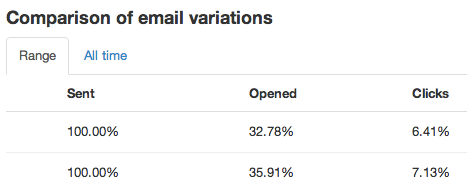- All Posts
- /
- Email AB testing ideas and tips
Email AB testing ideas and tips
Messaging and Automation-
 Chris Hexton
Chris Hexton
-
Updated:Posted:
On this page
You’re probably sitting there thinking ‘A/B testing my emails is too hard‘, ‘I don’t have enough people to bother‘ or ‘where do I even start?‘
Right…right?
That’s pretty normal: not enough online businesses A/B test their email campaigns! So be different: it’s not hard and by doing so you’ll stay ahead of the competition.
Here are three examples of subject line A/B split tests from real world businesses that have actionable results.
Each test employs some email marketing tricks. Let’s break ‘em down one-by-one so you can harness their power when doing your own testing!
1. Be afraid, be very afraid: use the power of fear.
People hate missing out.
We hate it so much we fear it.
This fear is innate and psychologically very powerful.
Add to this the fact that people remember and engage based on their feelings and you have a strong case for embracing fear.
As this great presentation describes, emotions are part of a great story and a great story is great marketing (check out slide 33).
You need to make your customers feel what you’ve got to say.
This email from Thanh over at Asian Efficiency is a simple, but effective, example.
A massive A/B tester, Thanh has found time-and-again that subject lines that make the customer feel as though they’re missing out work extremely well.
Take a look at this recent campaign Thanh sent out on improving your sleeping patterns to improve efficiency.

Of the four variations the winning subject line was undoubtedly “The invisible trick to get more energy and stuff done” – it was the most effective by 24%.
Nice.
This article from Joanna over at CopyHackers enforces the notion of making your customers feel.
Similar to subject lines, Joanna breaks down some great landing page headlines and suggests some alternate (read: much better) variations. You’ll notice that most of the improved headlines employ a heavy element of fear. For example:
Crisis narrowly averted vs. Find Your Next Job Now – Before You Get Sacked.
Which one do you think would have a bigger impact?
The latter!
Why? It embraces fear and makes the reader feel the pain.
The point: Embrace fear when writing your subject lines.
2. Ask why…don’t tell them how
This test comes from the guys over at Strikingly.com.

The subject line was tested in these two emails and, over time and many hundreds of emails the first variation, with subject line Why Stay Competitive on Mobile influenced opens and clicks by just over 10% in both cases.
The body of each email was exactly the same, the influence was all in the subject.
Simon Mainwaring over at WeFirst writes about the ‘how’ vs. the ‘why’ when it comes to branding and marketing.
His point is simple: people need to understand the why before making a decision.
As humans we don’t just do things because we’re told to, we need to understand why we should do them!
This A/B test proves this holds true when it comes to writing your subject lines.
‘Why’ is also a question word. It generally precedes a question and asks people to think something through.
Questions are powerful in and of themselves. Anecdotally, the guys at Striking.ly have found that whenever they include a direct question as a call to action at the end of an email, particularly a personal one from David the founder, they get an overwhelming response.
They recently did this as part of their welcome email (a cool tactic discussed more in my post discussing how customers actually read your emails) and it was so successful they had to turn it off as they couldn’t keep up with the responses!
The point: communicate the ‘why’ with your customers. Ask them the question and let them convince themselves of the answer and your marketing will be much more effective.
3. BOOM! Use impact words (oh, and be personal)
This is a test that’s been running for a good while now at Vero.
The campaign, sent on day four of the free trial, aims to educate new customers about what they can do with lifecycle emails.
Out of these two, which do you think wins?

Ding, ding, ding…number two takes the lead by a massive 15% for the open rate and 50% for the click through rate.

You’ll be interested to note that the content in these emails is exactly the same, it’s just the subject line that changed.
There are two things going on here:
- The first variation is much less personal. Although generally useful to remind customers of WHO is sending the email this is better achieved with the from name, something along the lines of ‘Chris from Vero’.
- The second version has purpose. The word converts resonates much stronger with the Vero audience than the word works, whatever that even means ;).
The guys at HelpScout mention in their 10 Things Your Customers With You Know About Them feature that customers will remember you if you remember their names.
The point is that personalization and making a connection are vital to engagement. This explains why removing the cold ‘[Vero]’ from the subject contributes to the uplift in opens.
Similarly, this example from Dan Norris at
Inform.ly comes from an update
to his blog mailing list: Dan has tested the use of the word ‘hack’ – a topical, ‘impact’
word – against the less direct ‘simple secret’.
Dan has tested the use of the word ‘hack’ – a topical, ‘impact’
word – against the less direct ‘simple secret’.
Using the term ‘hack’ increased click throughs by 28%.
That’s a convincing win in my book!
The point: Next time you’re writing a subject line give it impact. Use words with purpose and watch your results sky rocket!
Over to you
What A/B tests have you tried and seen work? Why do you think these tips and tricks would or would not work for your mailing list?

